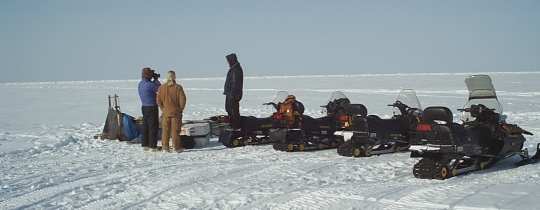Sea ice
Find out about our research into measuring the physical properties of sea ice.

Sea ice is a composite of solid ice and brine pockets, which are incorporated into the ice as sea water freezes.
Sea ice covers up to 7% of Earth's surface at any one time, so it is an important component of climate models. Developing an understanding of its microstructure and variations with temperature, season, and location, is therefore extremely important.
The size, distribution and connectivity of the brine component of the ice varies dramatically with temperature. This has a large impact on many of the physical properties of the sea ice, such as heat and fluid transfer and its interaction with electromagnetic radiation.
Measuring sea ice properties
It is not easy to measure the physical properties of sea ice in-situ, and care must be taken not to disturb the natural state of the ice. In addition, many sea ice properties are anisotropic. We use a variety of techniques developed from electrical geophysics, to study how the bulk electrical resistivity and the permittivity of the ice changes with time, particularly in the spring as the temperature warms and the ice thaws.
We are also interested in how these properties differ in sea ice which grows under different environmental conditions. We study laboratory grown saline ice, and also carry out theoretical computational work on the physical properties of ice.
We collaborate with sea ice research groups nationally and internationally including the University of Otago, the University of Alaska Fairbanks and the University of Utah.
Students have the opportunity to be part of field work - we have undertaken campaigns in both the Arctic and the Antarctic over the years.
Past student research projects
- Keleigh Jones (PhD, 2011), Tracking the evolution of sea ice microstructure using cross-borehole resistivity tomography
- Sean Buchanan (MSc, 2010), The low frequency electrical properties of sea ice
- Sam Turner (BSc(Hons), 2010), Laboratory impedance measurements on saline ices
- Ann Hibbard (BSc(Hons), 2010), Electromagnetic measurements of sea ice thickness
- Rufus Boyack (BSc(Hons), 2009), Measurement of the permittivity of artificial sea ice using AC cross-borehole tomography
- Duncan McCann (BSc(Hons), 2009), Modelling electrical resistivity in sea ice
Available student research projects
Interested students should contact Malcolm Ingham. Well qualified students are encouraged to apply for Te Herenga Waka—Victoria University of Wellington PhD and MSc Scholarships.
- Measurement of permittivity of sea ice using ac cross-borehole resistivity tomography (PhD)
- Laboratory investigation of the impedance of saline ices (MSc)
Academic staff
Research Fellow
School of Chemical and Physical Sciences
Senior Lecturer
School of Engineering and Computer Science




